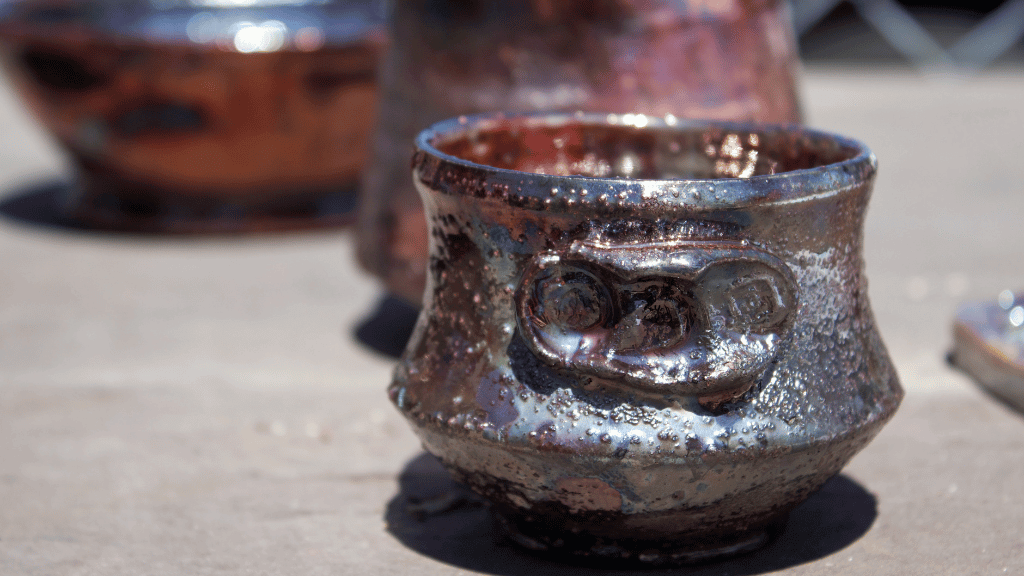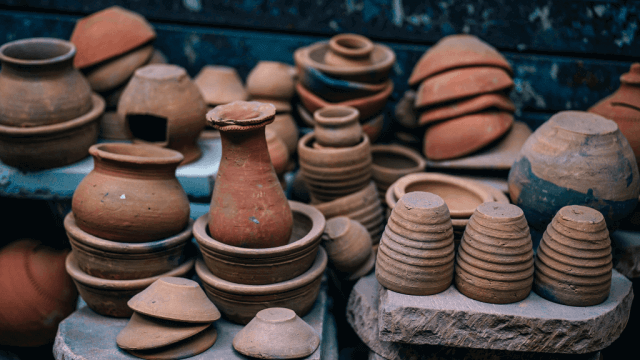Raku pottery is a traditional Japanese ceramic technique that involves firing clay pieces at low temperatures, removing them from the kiln while still hot, and placing them in a container with combustible materials to create striking colors and patterns.
The process results in unique and unpredictable effects on each piece of pottery produced.
An Overview of Raku Pottery
Raku pottery, originating in 16th century Japan, is a low-temperature ceramic technique emphasizing the unique, unpredictable, and rapid firing process.
Due to its distinct qualities, Raku pottery brings a sense of natural beauty and spontaneity to the works it creates.
The Raku Firing Process
Stage 1: Shaping and Bisque Firing
The clay is first shaped by hand or on a potter’s wheel and allowed to dry.
Once dry, it undergoes an initial firing, called a bisque firing, to remove any moisture and harden it.
Stage 2: Glazing and Decorating
After cooling, the pottery is glazed using special Raku glazes, often rich in metal oxides.
These glazes create unique color effects during the rapid firing process.
Decorative elements such as wax resist, slips or engobes, and additional glazes can be applied to create interesting patterns and contrasts.
Stage 3: Raku Firing
The glazed pottery is placed in a Raku kiln and fired up to temperatures of 1600-1800°F (870-980°C).
Once the glazes have reached their melting point, the kiln is quickly opened, and the red-hot pottery is removed using tongs.
Stage 4: Post-Firing Reduction
The pottery is then plunged into a container filled with combustible materials like sawdust, leaves or newspaper.
The materials ignite and produce smoke, which is trapped inside the sealed container.
This reduction atmosphere creates unique color variations and patterns on the pottery’s surface.
Stage 5: Cooling and Cleaning
After a brief reduction period, the pottery is removed from the container, cooled rapidly, and cleaned to reveal its final vibrant and unique appearance.
Distinct Qualities of Raku Pottery
Raku pottery embodies several unique characteristics, such as crackled glaze surfaces, vibrant metallic colors, and carbonized black clay.
The rapid firing process and the unpredictable results make each Raku piece a one-of-a-kind work of art, reflecting the natural beauty and harmony that this art form strives to convey.
Raku Pottery and Tea Ceremonies
Raku pottery originated in Kyoto, Japan, and was deeply connected to the traditional Japanese tea ceremony.
The technique was developed by Chojiro, a master potter credited with creating the first Raku tea bowl.
The unique qualities of Raku pottery, such as its organic forms and earthy textures, made it an ideal choice for tea ceremonies that emphasize the connection between the natural world and human experience.
Different Types of Raku Pottery
There are two primary styles of Raku pottery, each with its distinctive characteristics:
Traditional Japanese Raku Pottery
Also known as “East Raku,” traditional Japanese Raku focuses mainly on hand-built tea bowls and related utensils.
These pottery pieces often feature subdued colors, minimal decoration, and emphasize the natural clay body.
Western-Style Raku Pottery
Developed in the mid-20th century and sometimes called “West Raku,” this style embraces a broader range of forms, techniques, and decorative elements to create dramatic colors, patterns and finishes, resulting in a more diverse range of ceramic artworks.
Caring for Raku Pottery
Due to the low firing temperatures and rapid cooling process, Raku pottery is somewhat more porous and fragile than other types of ceramics.
It’s essential to handle your Raku pottery with care and avoid using it for food, beverages, or holding water.
To clean Raku pottery, gently dust or wipe it with a soft cloth, as abrasive materials or water submersion may damage the piece.
Creating Your Own Raku Pottery
If you’re interested in trying out Raku pottery yourself, consider taking a workshop or class that specializes in the technique.
Many pottery studios offer Raku-specific sessions where you can experience the process, taught by experienced potters.
Classes generally cover the basics of the process and teach you the necessary safety precautions for handling and firing Raku pottery.
FAQs about Raku Pottery
If you’re new to Raku pottery or interested in learning more, check out the answers to these commonly asked questions about the technique and what to expect.
Can Raku pottery be used for food, beverages, or as vases?
No, due to its porous nature and fragile characteristics, Raku pottery is mainly intended for decorative purposes.
It is not food safe, and holding water or beverages may damage the piece.
What type of clay is best for Raku pottery?
Raku pottery works best with grogged or coarse clay bodies, which provide higher thermal shock resistance during the rapid firing and cooling process.
These types of clay contain materials that help reduce the risk of cracking or breaking due to temperature fluctuations.
Are there any safety concerns when creating Raku pottery?
Yes, safety is crucial when working with Raku pottery.
The process involves handling red-hot ceramics and exposure to combustible materials, which can be dangerous if not managed correctly.
It’s essential to work with experienced potters, use protective gear, and observe necessary safety precautions during the Raku process.
How long does the Raku process take from start to finish?
The Raku process can vary in length but is generally much shorter than most ceramic firing procedures.
The actual Raku firing stage lasts anywhere from 30 minutes to 2 hours, while the post-firing reduction takes an additional 10 to 30 minutes.
However, keep in mind that preparation, glazing, and initial bisque firing can add more time to the overall process.
Why is Raku pottery associated with the Japanese tea ceremony?
Raku pottery, originating in 16th century Japan, was closely connected to the traditional Japanese tea ceremony as it emphasizes natural beauty, simplicity, and harmony—principles that align with the aesthetics of the ceremony.
The organic forms and textures of Raku pottery complemented the tea ceremony, where participants appreciate the interconnectedness between humanity and nature.











